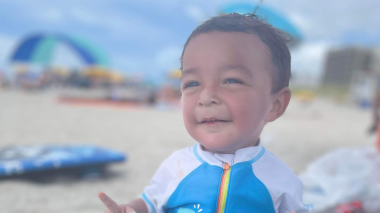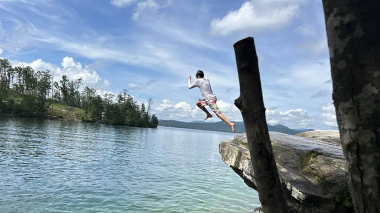10-year-old Ava Grace Sage goes by “Gracie'' to all who have the honor of knowing her. Gracie loves soccer, fried pickles, and playing with her twin brother, Jackson, and younger sister, Isabella. She loves fiercely, lives fully and gives generously.
Gracie’s parents, Jenny and Chris, describe her as loving and empathetic, but there aren’t enough words to explain the magnitude of Gracie’s big-hearted nature.
Earlier this year, Gracie’s school organized a stuffed animal drive for Atrium Health Levine Children’s Hospital. Jenny says she remembers Gracie coming home from school extremely upset because there were only a few donations in the bin.
“She asked me if I would take her to the store so she could use $50 of her own birthday money to buy some more stuffed animals for the kids at Levine Children’s,” Jenny says. “The next day, the donation bin was full.”
Gracie’s devotion to Levine Children’s runs deep. When she was two weeks old, Gracie spent some time in the neonatal intensive care unit (NICU) to treat her sleep apnea. She was able to
return home several days later. But the level of care they received during their time at Levine Children’s stuck with Gracie’s parents.
In June 2022, Jenny and Chris chose the team of experts at Atrium Health Levine Children’s Hospital, a Best Children’s Hospital for cancer care according to U.S. News & World Report, when a bump on Gracie’s upper stomach turned their whole world upside down.
A Staggering Diagnosis
When Gracie told Jenny about the bump just below her ribs, Jenny thought it looked like a bug bite. But she took Gracie to her pediatrician to have it checked out.
“Thankfully, Gracie’s doctor didn’t want to just ‘wait and see,’” Jenny says. “So we were referred to a surgical group that did an ultrasound and an MRI. They didn’t think it was cancerous, but they decided to do a biopsy just in case.”
It wasn’t until Gracie’s tumor was removed that Jenny and Chris heard the words no parent ever wants to receive.
“There is nothing like being in a conference room at a hospital and being told that your child has cancer,” Jenny says.
Although the term “sarcoma” was used to describe Gracie’s tumor, Gracie’s official diagnosis was still undetermined.
After multiple consultations with doctors and specialists, Jenny and Chris recalled their experience at Levine Children’s and decided to seek out the expertise of the award-winning pediatric cancer team.
Jenny and Chris met with Dr. Javier Oesterheld, cancer specialist at Levine Children’s, and knew immediately they found the right fit.
“Dr. Oesterheld was so knowledgeable and confident, which put our minds at ease,” Jenny says. “Even though we were still seeking a diagnosis, we just knew we were where we needed to be.”
Later that day, Jenny and Chris learned that Gracie’s cancer had spread. They had no doubt about their next step: They immediately moved Gracie’s cancer care to Levine Children’s.
Two weeks later, after much research and consulting with his peers across the country, Oesterheld delivered Gracie’s diagnosis: A rare type of soft tissue cancer called CIC-DUX4 sarcoma (CDS).
Oesterheld explains that CDS, or CIC-rearranged sarcoma, is a subcategory of small round cell sarcoma. CDS is based on the translocation of genes – which typically occurs when a chromosome breaks apart and the fragmented pieces re-attach to different chromosomes.
“This genetic component, paired with the fact that it was on Gracie’s skin, makes it incredibly uncommon,” Oesterheld says.
Jenny says the hardest thing about Gracie’s diagnosis was the rarity of it. There are less than 200 cases reported to date, and there is no definite treatment plan.
The good news is that the tumor had already been removed, but Jenny says Gracie did not have clear margins, meaning there were still cancer cells at the edge of the tissue. So Oesterheld’s first priority in treating Gracie was to surgically remove the remaining cancerous tissue around the tumor. She also had a port placed for her chemotherapy treatments.
Gracie then underwent some heavy-hitting treatment – including 12 chemotherapy infusions and 21 IV infusions.
Due to the rarity of Gracie’s diagnosis and the potential long-term effects of her treatment, Jenny says the pediatric cancer survivorship program at Levine Children’s had been an added layer of care that she is grateful that Levine Children’s offers. Gracie survivorship team works to identify potential health risks and take steps to prevent or manage them.
A Familial Bond
Jenny says she and Chris are also grateful for how the team at Levine Children’s considered and anticipated each family member’s needs throughout Gracie’s treatment.
“The nurses, doctors and Child Life specialists at Levine Children’s played an integral part in helping our family get through the most difficult thing we’ve ever had to face.”
In addition to connecting Jenny and Chris with resources, the Child Life team worked with Jackson and Isabella to explain what their sister was going through and answer any questions they had along the way. A Child Life specialist also went with Gracie to school one day to help educate her classmates about her treatment and ways they could support her.
Jenny says Gracie’s care team started to become part of their family.
“Being immunocompromised means you can’t see your own family and friends sometimes,” Jenny says. “So they became that special community for us when we needed it most.”
A Bittersweet Bell-Ringing
Gracie became so tightly knit with her care team that she cried when she rang the bell that signified the end of her treatment. The walls were lined with those who grew to adore Gracie, celebrating with her as the sound of the bell echoed down the halls.
“Gracie was glad to be done with her treatment,” Jenny says. “But she was also really sad – she was going to miss all the people there who had been with her every day, each step of the way.”
Due to the rarity of her cancer, Gracie has scans every three months for the next two years, potentially shifting to every four months after that, depending on her progress. Jenny says it’s hard not to have “scanxiety” each time Gracie’s scans are looming. But they try to stay focused on embracing their time together each day.
Gracie has also been able to get back to one of her biggest passions: playing soccer. She recently made the travel soccer team and is excited to continue to hone her skills.
Oesterheld says he is glad to see Gracie thriving, and hopes she continues to be cancer free so she can live her childhood to the fullest.
“Gracie’s energy is infectious and her family is so incredibly gracious,” Oesterheld says. “They handled a difficult situation with her diagnosis so beautifully.”
Difference-Makers
Gracie’s journey has brought a lot of sadness, but Jenny hopes they can use their experience as a platform to continue to help other people.
“We’re huge advocates for raising awareness about pediatric cancer,” Jenny says. “The work Levine Children’s is doing to further research in this space gives me hope. The investment from the community is incredible and the team working to further this body of research are truly difference-makers.”
Gracie herself might be one of those researchers one day. She says one of her biggest goals for her future is to cure cancer so other kids don’t have to go through what she experienced.
“People tend to talk about how resilient kids like Gracie are after all they’ve been through,” Jenny says. “But this is a really hard journey for these little humans. It’s emotionally and physically draining. She is resilient, but she’s been through so much. And I’ve never been more proud to be her mom.”



